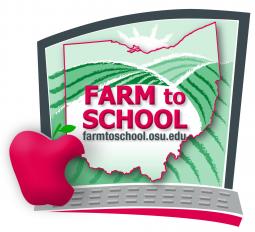The USDA, in its first national Farm to School Census, determined that a third of school districts sampled throughout Ohio are engaged in farm to school activities. Research has shown that children in schools with farm to school programs eat more fruits and vegetables and are more willing to try and eat the new, healthy foods served in school breakfasts, lunches and snacks — positive steps in the fight against childhood obesity.
In the state of Ohio there are approximately 616 public school districts, 409 of which completed the census. 137 of the responding districts, or 33 percent, reported participating in farm to school activities in the 2011-2012 school year. Those 137 districts include 833 individual schools with about 425,061 students.
Farm to school initiatives in Ohio involve connecting schools (pre-K through college) with local farms by supporting procurement of fresh, nutritious foods from the farms to be served in school cafeterias and by offering student experiential learning opportunities through farm visits, school gardens, food and nutrition educational activities, and an incorporated nutrition education curriculum. Such initiatives serve to help support local farmers and keep food dollars in local economies. For example, the Ohio school districts that bought local products in the 2011-2012 school year spent an estimated $34,780,859 on school food, with over 10% ($3,912,708) of that directed locally.
“The Ohio data indicates a growing interest in serving local foods among schools across our state,” said Carol Smathers, Field Specialist at Ohio State University Extension. “The responses also indicate potential areas for growth in procurement of local foods and experiential learning activities related to those foods.”
Fruits and vegetables such as apples, tomatoes, lettuce, peppers, and cucumbers were among the most popular local products purchased by school districts in Ohio. By providing children with fresh, local food, combined with nutrition education, farm to school programs help young people understand where their food comes from and how food choices affect their health, environment and community.
The census estimated that an additional 10 percent of Ohio respondents said they plan to purchase local foods in the future. “OSU Extension will continue to reach out to school food service personnel to help support their efforts to bring farm fresh foods to school cafeterias,” said Smathers. Hopefully, through increased awareness and further evidence of positive outcomes, these numbers will continue to grow.
Ohio State University Extension provides leadership for the statewide program and representation in the National Farm to School Network. To learn more, visit the Ohio Farm to School website.
Written by:
Bridgette Kidd, MPH, RD
Healthy People Program Specialist, Family and Consumer Sciences
Ohio State University Extension
kidd.149@osu.edu
Reviewed by:
Linnette Goard
Field Specialist, Family and Consumer Sciences
Ohio State University Extension.
Sources:
The Farm to School Census. United States Department of Agriculture Food and Nutrition Service. Retrieved October 25, 2013 from http://www.fns.usda.gov/farmtoschool/census#/
Aftosmes A. (2011). Impact of Farm-to-School Programs: A Research Brief to the Massachusetts Food Policy Council. Harvard Catalyst. Retrieved October 25, 2013 from http://catalyst.harvard.edu/pdf/chirp/Farm_to_School.pdf





